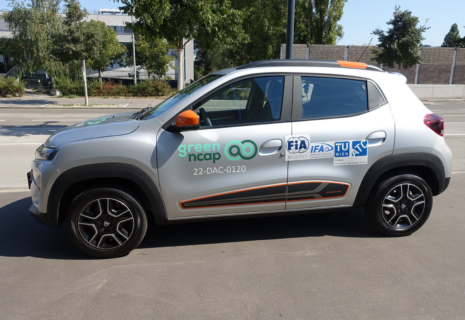Dacia Spring 33 kW electric FWD automatic
2022
99%
10.0
10
Clean Air Index
9.8
10
Energy Efficiency Index
10.0
10
Greenhouse Gas Index
| Laboratory Tests | NMHC | NOX | NH3 | CO | PN | |
|---|---|---|---|---|---|---|
| 10.010 | Cold Test | |||||
| 10.010 | Warm Test | |||||
| 10.010 | Highway | |||||
| 10.010 | Cold Ambient Test | |||||
| Road Test | ||||||
| 10.010 | On-Road Drive | |||||
| 5.05 | On-Road Short Trip | |||||
| 8.08 | On-Road Heavy Load | |||||
| 5.05 | On-Road Light Load | |||||
| 2.02 | Congestion | |||||
| Laboratory Tests | Energy | |||
|---|---|---|---|---|
| 10.010 | Cold Test | 16.2kWh100 km | ||
| 10.010 | Warm Test | 16.2kWh100 km | ||
| 9.610 | Highway | 23.0kWh100 km | ||
| 9.610 | Cold Ambient Test | 22.5kWh100 km | ||
| Consumption | Driving Range | |||
| Average | 18.5kWh100 km | 180km | ||
| Worst-Case | 23.0kWh100 km | 141km | ||
| Greenhouse Gases | CO2 | N2O | CH4 | |
|---|---|---|---|---|
| 10.010 | Cold Test | |||
| 10.010 | Warm Test | |||
| 10.010 | Highway | |||
| 10.010 | Cold Ambient Test |
Specifications
- Tested Car UU1DBG006MU01XXXX
- Publication Date 08 2022
- Vehicle Class City and Supermini
- Emissions Class Euro 6 AX
- Tyres 165/70 R14 81H
- Mass 970 kg
- System Power/Torque 33 kW/125 Nm
- Declared Battery Capacity 26.8 kWh
- Declared Driving Range Overall 230 km City 314 km
- Declared Consumption 13.9 kWh/100 km





























































































































































Our verdict
Update October 2022: The results of the Cold Ambient Test have been updated, the rating results remain unchanged.
Dacia's new electric model - the Spring - is a compact city vehicle of a SUV design. Its modest power of 33 kW limits the dynamic characterisitcs, but will appeal to those looking for functional, clean, efficient and affordable individual urban mobility. At 23°C ambient temperature, a driving range of about 140 km can be expected on the Highway. The test results prove the Spring to be an environmentally friendly car, not only due to the absence of local pollutant emissions but also because of its low energy consumption. With 5 Green Stars and an overall index of 9.9, Dacia's super mini sets an example to others.